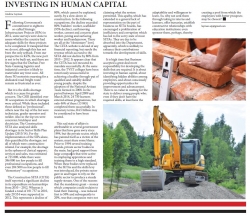Andrew Layman - Investing In Human Capital2017-04-12 Following Government’s commitment to eighteen so-called Strategic Infrastructure Projects (SIPs) in 2012, some surveys were done to assess whether the country had adequate skills for these projects to be completed. It transpired that we do not, although this has not been the only setback. From our perspective in KZN, the new port is not to be built yet, and there are few signs that the Durban-Free State-Gauteng logistics and industrial corridor is likely to materialize any time soon. All those N3 motorists yearning for a dedicated road freight route remain as frustrated as ever.
But it is the skills shortage which is a cause for greater concern. The CSIR identified over 30 occupations in which shortages were critical. While these included those defined as “professionalâ€, others near the top of the list were technician, grader operator and welder. Also in the top ten were concreter, bricklayer and electrician. The Construction SETA also analysed skills shortages in its Sector Skills Plan Update (2013/14). For the implementation of the SIPs alone, this quantified the shortages, not all of which were construction- related. For example, the shortage in the spheres of clerical support, services and sales, was estimated at 725 000, while there were 386 000 too few people to fill professional occupations, and even 284 500 too few people to fill “elementary†occupations. The Construction SETA (CETA) itself reported a significant decline in its expenditure on learnerships from 2010 â€" 2012. Whereas it funded a total of 101 737 in 2010, only 20 534 were supported in 2012. This represents a decline of 80%, which cannot be explained, surely, by a slow-down in construction. In the following occupations, the decline exceeded 80%: builders’ worker, scaffolder (93% decline), earthmoving worker, cement and concrete plant worker, paving and surfacing worker and handyperson. These are all at the “elementary†level. The CETA website is devoid of any financial reporting, but surely the revenue which accrued to the SETA did not decline by 80% from 2010 â€" 2012. It appears clear that the CETA has not executed its mandate successfully. At the same time, the TVET colleges have been notoriously unsuccessful in achieving a healthy through-put of qualified and suitably skilled young people, despite the adoption of the National Artisan Team formed in 2008. In the period between April 2009 and March 2014, 24 750 learners entered artisan programmes, but only 46% of these (13 845) completed them successfully. In monetary terms, R4.5 billion may be considered to have been wasted. This sad state of affairs is attributable to several government plans that have gone awry since 1994, but the private sector, which has painted itself as a victim of the system, must share some blame. Prior to 1994 several training boards, private sector bodies in the main, had good support from large companies that were active in employing apprentices and training them to a high standard. When these bodies were replaced by the SETAs and the skills levy was introduced, the private sector gave in and began to rely on the public sector to produce a steady supply stream. One of the reasons that the mandatory grant â€" money which companies could reclaim to fund their training â€" was reduced first to 50% and subsequently to 20%, was that companies were not claiming what the system permitted. This apathy, which has extended to a general lack of representation on the part of business on SETA boards, has encouraged a proliferation of inefficiency and corruption which has led to the sorry state of most SETAs. They are due to be absorbed into the Department, apparently, which is unlikely to enhance their contributions towards the development of skills. It is high time that Business accepted a great deal more responsibility for developing the skills that are required. It is about investing in human capital, about identifying hidden abilities among employees, and about consciously providing opportunities for improvement and advancement. There is no value in waiting for the state to deliver young people who, even if they don’t have the required skills, at least have the adaptability and willingness to learn. So, why not seek them through taking in interns and learners, offer bursaries, establish constructive relationships with education institutions; even sponsor them, perhaps, thereby creating a pool from which the employees with better prospects may be chosen? layman.uip@gmail.com |
Andrew Layman - Investing In Human Capital
Copyright © 2025 KwaZulu-Natal Top Business
